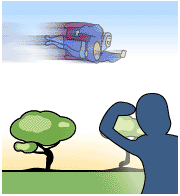

![]()
![]()
![]()
![]()
![]()
![]()
![]()

Graphics by Art
for the web
|
|
http://www.nobel.se/physics/educational/tools/relativity/transformations-2.html |
A direct consequence of time dilation is length contraction. As stated before, when an object approaches near light speeds, the time it perceives is slower relative to the time perceived by a stationary object. If we were to expand on this idea, we could say that it would take less time to travel a certain distance relative to a stationary object compared to the time required if we did not take into account Einstein's postulates. It is from this idea that we get length contraction. Basically, the perceived distance from point a to b relative to a fast moving object is less than the perceived distance for a stationary object
To illustrate this point, let’s assume that we are in a spaceship
and are traveling toward a planet. When the spaceship is stationary
relative to the planet, it is 100000 meters away. This is known as the
proper length, denoted as Lo. If the spaceship were moving at 90% the
speed of light toward the planet, it's own time would be moving slower
than the planet's time. Therefore, we can conclude that the distance
from the spaceship to the planet appears to be less than if both were
stationary. We can make the calculation of how large the new distance
is by following the equation below. Once again, we bring back the term
gamma we used for calculating time dilation. By taking a look at the
final equation we can see that all that is required is to divide the
proper length by gamma. This will result in the apparent length.

